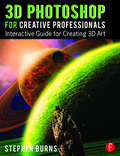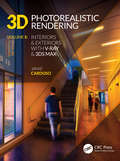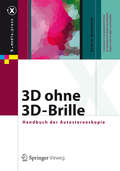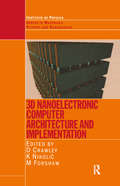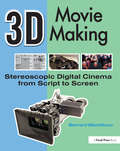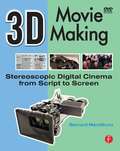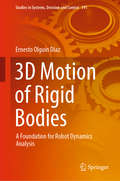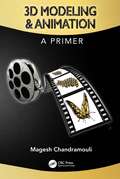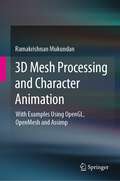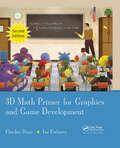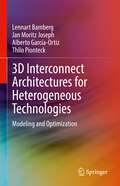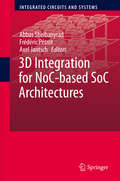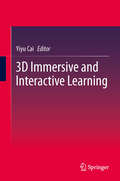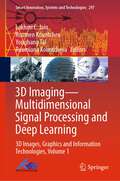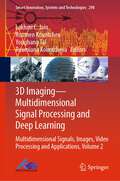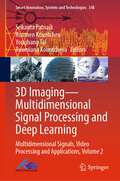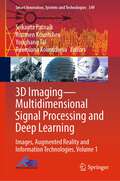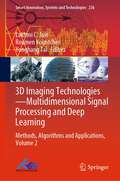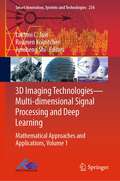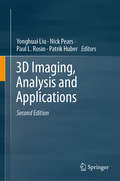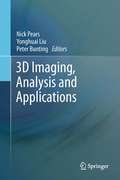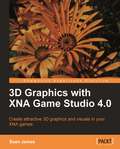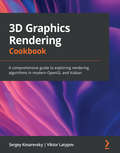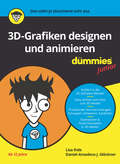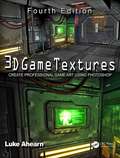- Table View
- List View
3D Photoshop for Creative Professionals: Interactive Guide for Creating 3D Art
by Stephen BurnsPhotoshop is the cornerstone of the graphics industry and understanding its 3D capabilities is becoming a requirement for graphic designers, photographers, and creatives alike. Starting with the fundamental tools and ending with advanced resources, Adobe Community Professional Stephen Burns guides you with a clear voice and creative exercises that encourage you to work as you read. Accompanied by a free app that includes video tutorials, interactive models to compare your activity work from the book against, and on-going updates about the latest Photoshopreleases, this book will elevate your art off the page and into a new world of possibilities. (The app is available for the iPad and iPhone in the iTunes App Store, and Android users can find it through Google Play. Just search for 3D Photoshop on either of these platforms and download it to your device.)
3D Photorealistic Rendering: Interiors & Exteriors with V-Ray and 3ds Max (3D Photorealistic Rendering)
by Jamie CardosoIncrease the photorealism of your 3d visualizations with enhanced toolsets of V-ray in 3ds Max. Full-color, step-by-step tutorials about techniques involved in creating photorealistic renders for interior/exterior scenes. Each tutorial includes a 3d project scene to guide you through, production and post-production. The production chapter shows how to create shaders, fine-tune textures and set up a day/night lighting rig. You will be rendering high-res images with render elements included for the final stage of post-production. The book also includes tips about, pre-production, camera settings, verified views, material editors, shaders, 3ds max scripts, and much more!
3D ohne 3D-Brille: Handbuch der Autostereoskopie (X.media.press)
by Armin GrasnickSeit dem kommerziellen Erfolg des 3D-Blockbusters ,,Avatar" im Jahr 2009 kommen immer mehr 3D-Filme und 3D-Fernseher auf den Markt. Mittlerweile gibt es Autostereoskopie-Verfahren, bei denen Zuschauer keine 3D-Brille mehr benötigen. In dem Band werden die derzeit verfügbaren Technologien der Autostereoskopie, ihre Funktionsweise, Anwendung und Limitierung allgemeinverständlich beschrieben. Zu jeder Technologie liefert der Band Anleitungen und Beispiele für die Erstellung von 3D-Inhalten. Alle Tools sind auf der begleitenden Internetseite verfügbar.
3D Nanoelectronic Computer Architecture and Implementation (Series in Material Science and Engineering)
by K. Nikolic M. Forshaw David CrawleyIt is becoming increasingly clear that the two-dimensional layout of devices on computer chips hinders the development of high-performance computer systems. Three-dimensional structures will be needed to provide the performance required to implement computationally intensive tasks. 3-D Nanoelectronic Computer Architecture and Implementation reviews the state of the art in nanoelectronic device design and fabrication and discusses the architectural aspects of 3-D designs, including the possible use of molecular wiring and carbon nanotube interconnections. This is a valuable reference for those involved in the design and development of nanoelectronic devices and technology.
3D Movie Making: Stereoscopic Digital Cinema from Script to Screen
by Bernard MendiburuHollywood is going 3D! Join the revolution with this primer to all of the essential skills for live action 3D, from preproduction through distribution.3D perception and science is presented in an accessible way that provides the principles of Stereoscopic vision you need to make the transition from the 2D world. Tools of the trade are enumerated with an eye on current constraints and what is coming down the pike to smooth the way. Step-by-step instructions detail how 3D processes affect every stage of the production including screenwriting, art direction, principle photography, editing, visual effects and distribution.The downloadable resources include an array of 2D and 3D images that demonstrate concepts and techniques, 3D movie shorts that showcase alternative techniques, After Effects project files to explore and manipulate for effect, and a resource list of software tools and tutorials that demonstrate techniques.
3D Movie Making: Stereoscopic Digital Cinema From Script To Screen
by Bernard MendiburuHollywood is going 3D! Join the revolution with this primer to all of the essential skills for live action 3D, from preproduction through distribution. 3D perception and science is presented in an accessible way that provides the principles of Stereoscopic vision you need to make the transition from the 2D world. Tools of the trade are enumerated with an eye on current constraints and what is coming down the pike to smooth the way. Step-by-step instructions detail how 3D processes affect every stage of the production including screenwriting, art direction, principle photography, editing, visual effects and distribution. The companion DVD includes an array of 2D and 3D images that demonstrate concepts and techniques, 3D movie shorts that showcase alternative techniques, After Effects project files to explore and manipulate for effect, and a resource list of software tools and tutorials that demonstrate techniques. The DVD is not included with the E-book. Please contact the publisher for access to the DVD content by emailing dennis.mcgonagle@taylorandfrancis.com
3D Motion of Rigid Bodies: A Foundation for Robot Dynamics Analysis (Studies in Systems, Decision and Control #191)
by Ernesto Olguín DíazThis book offers an excellent complementary text for an advanced course on the modelling and dynamic analysis of multi-body mechanical systems, and provides readers an in-depth understanding of the modelling and control of robots. While the Lagrangian formulation is well suited to multi-body systems, its physical meaning becomes paradoxically complicated for single rigid bodies. Yet the most advanced numerical methods rely on the physics of these single rigid bodies, whose dynamic is then given among multiple formulations by the set of the Newton–Euler equations in any of their multiple expression forms. This book presents a range of simple tools to express in succinct form the dynamic equation for the motion of a single rigid body, either free motion (6-dimension), such as that of any free space navigation robot or constrained motion (less than 6-dimension), such as that of ground or surface vehicles. In the process, the book also explains the equivalences of (and differences between) the different formulations.
3D Modeling & Animation: A Primer
by Magesh Chandramouli"If I were still teaching introductory computer graphics, I would not hesitate to use this textbook as it has just the right amount of coverage of the topic for a semester course and is presented in a highly appealing manner to engage the reader." – Gary Bertoline, PhD, Distinguished Professor of Computer Graphics Technology, Purdue University, USA Graphics-based 3D modeling and animation are relevant not only in the motion picture and video game industry, but also in many other disciplines including creative arts, engineering, architecture, education, medicine, etc. Understanding the basics of 3D modeling, and animation requires understanding some basic concepts in physics and math. While some books assume readers’ prior knowledge of these concepts, 3D Modeling & Animation: A Primer explains these important concepts in a visually engaging manner. This book is not just for university students, but for anyone with an interest in computer graphics modeling and animation. Using a Software-Agnostic approach, this book focuses on modeling and animation concepts spanning across multiple software platforms. Employing a balanced approach that is neither too technical nor too artistic, this book instills the need for creativity and visual composition in animation. KEY FEATURES: • Uses a simple, clear, and concise approach to explain the basics of modeling and animation • Two hundred plus vibrant images to easily understand and appreciate complex concepts • Review questions at chapter ends to help readers better review the content AUTHOR: Magesh Chandramouli is a Professor of Computer Graphics Technology at Purdue University Northwest and is a Distinguished Visiting Faculty of Computer Graphics at Feng Chia University, Taiwan. He is currently serving as the Director of Programs of the Engineering Design Graphics Division of the American Society for Engineering Education. He was a Frederick Andrews Fellow at Purdue University, West Lafayette, where he completed his PhD. He received Master of Science from the University of Calgary, Canada; Master of Engineering from the National University of Singapore; and B.E. from College of Engineering, Guindy, India. He has received National and International awards for his scholarly accomplishments and has delivered invited lectures in reputed universities and research centers around the world.
3D Mesh Processing and Character Animation: With Examples Using OpenGL, OpenMesh and Assimp
by Ramakrishnan Mukundan3D Mesh Processing and Character Animation focusses specifically on topics that are important in three-dimensional modelling, surface design and real-time character animation. It provides an in-depth coverage of data structures and popular methods used in geometry processing, keyframe and inverse kinematics animations and shader based processing of mesh objects. It also introduces two powerful and versatile libraries, OpenMesh and Assimp, and demonstrates their usefulness through implementations of a wide range of algorithms in mesh processing and character animation respectively. This Textbook is written for students at an advanced undergraduate or postgraduate level who are interested in the study and development of graphics algorithms for three-dimensional mesh modeling and analysis, and animations of rigged character models. The key topics covered in the book are mesh data structures for processing adjacency queries, simplification and subdivision algorithms, mesh parameterization methods, 3D mesh morphing, skeletal animation, motion capture data, scene graphs, quaternions, inverse kinematics algorithms, OpenGL-4 tessellation and geometry shaders, geometry processing and terrain rendering.
3D Math Primer for Graphics and Game Development (Wordware Game Math Library)
by Fletcher Dunn Ian ParberryThis engaging book presents the essential mathematics needed to describe, simulate, and render a 3D world. Reflecting both academic and in-the-trenches practical experience, the authors teach you how to describe objects and their positions, orientations, and trajectories in 3D using mathematics. The text provides an introduction to mathematics for
3D Interconnect Architectures for Heterogeneous Technologies: Modeling and Optimization
by Lennart Bamberg Jan Moritz Joseph Alberto García-Ortiz Thilo PionteckThis book describes the first comprehensive approach to the optimization of interconnect architectures in 3D systems on chips (SoCs), specially addressing the challenges and opportunities arising from heterogeneous integration. Readers learn about the physical implications of using heterogeneous 3D technologies for SoC integration, while also learning to maximize the 3D-technology gains, through a physical-effect-aware architecture design. The book provides a deep theoretical background covering all abstraction-levels needed to research and architect tomorrow’s 3D-integrated circuits, an extensive set of optimization methods (for power, performance, area, and yield), as well as an open-source optimization and simulation framework for fast exploration of novel designs.
3D Integration for NoC-based SoC Architectures (Integrated Circuits and Systems)
by Axel Jantsch Abbas Sheibanyrad Frédéric PétrotThis book presents the research challenges that are due to the introduction of the 3rd dimension in chips for researchers and covers the whole architectural design approach for 3D-SoCs. Nowadays the 3D-Integration technologies, 3D-Design techniques, and 3D-Architectures are emerging as interesting, truly hot, broad topics. The present book gathers the recent advances in the whole domain by renowned experts in the field to build a comprehensive and consistent book around the hot topics of three-dimensional architectures and micro-architectures. This book includes contributions from high level international teams working in this field.
3D Immersive and Interactive Learning
by Yiyu Cai3D technology is not new; research on 3D started back in early 1960s. But unlike in previous times, 3D technology has now rapidly entered our daily life from cinema to office to home. Using 3D for education is a new yet challenging task. This book will present several innovative efforts using 3D for immersive and interactive learning covering a wide spectrum of education including gifted program, normal (technical) stream, and special needs education. The book will also share experience on curriculum-based 3D learning in classroom setting and co-curriculum-based 3D student research projects. The book is organized as follows. Chapter 1 introduces the fundamentals of 3D educational technology and their applications in immersive and interactive learning. Chapter 2 discusses the use of virtual reality in teaching and learning of Molecular Biology. Chapter 3 presents the daVinci Lab @ River Valley High School. Chapter 4 describes the 3D education development process. Chapter 5 studies the adaption 3D system for learning gains in lower secondary normal (technical) stream. Chapter 6 investigates the effects of virtual reality technology on spatial visualization skills. Chapter 7 showcases a sabbatical program for students to use 3D for Science, Technology, Engineering and Mathematics (STEM) learning. Chapter 8 shares the use of 3D virtual pink dolphin to assist special education. The foreword of this book is written by Dr Cheah Horn Mun, Director, Education Technology Division, Ministry of Education, Singapore.
3D Imaging—Multidimensional Signal Processing and Deep Learning: 3D Images, Graphics and Information Technologies, Volume 1 (Smart Innovation, Systems and Technologies #297)
by Lakhmi C. Jain Roumen Kountchev Yonghang Tai Roumiana KountchevaThis book gathers selected papers presented at the conference “Advances in 3D Image and Graphics Representation, Analysis, Computing and Information Technology,” one of the first initiatives devoted to the problems of 3D imaging in all contemporary scientific and application areas. The two volumes of the book cover wide area of the aspects of the contemporary multidimensional imaging and outline the related future trends from data acquisition to real-world applications based on new techniques and theoretical approaches. This volume contains papers devoted to the theoretical representation and analysis of the 3D images. The related topics included are 3D image transformation, 3D tensor image representation, 3D content generation technologies, 3D graphic information processing, VR content generation technologies, multi-dimensional image processing, dynamic and auxiliary 3D displays, VR/AR/MR device, VR camera technologies, 3D imaging technologies and applications, 3D computer vision, 3D video communications, 3D medical images processing and analysis, 3D remote sensing images and systems, deep learning for image restoration and recognition, neural networks for MD image processing, etc.
3D Imaging—Multidimensional Signal Processing and Deep Learning: Multidimensional Signals, Images, Video Processing and Applications, Volume 2 (Smart Innovation, Systems and Technologies #298)
by Lakhmi C. Jain Roumen Kountchev Yonghang Tai Roumiana KountchevaThis book gathers selected papers presented at the conference “Advances in 3D Image and Graphics Representation, Analysis, Computing and Information Technology,” one of the first initiatives devoted to the problems of 3D imaging in all contemporary scientific and application areas. The two volumes of the book cover wide area of the aspects of the contemporary multidimensional imaging and outline the related future trends from data acquisition to real-world applications based on new techniques and theoretical approaches. This volume contains papers aimed at the multidimensional systems and signal processing, deep learning, mathematical approaches and the related applications. The related topics are multidimensional multi-component image processing; multidimensional image representation and super-resolution; compression of multidimensional spatio-temporal images; multidimensional image transmission systems; multidimensional signal processing; prediction and filtering of multidimensional process; intelligent multi-spectral and hyper-spectral image processing, intelligent multi-view image processing, 3D deep learning, 3D GIS and graphic database; data-based MD image retrieval and knowledge data mining; watermarking, hiding and encryption of MD images; intelligent visualization of MD images; forensic analysis systems for M3D graphics algorithm; 3D VR (Virtual Reality)/AR (Augmented Reality); applications of multidimensional signal processing; applications of multidimensional systems; multidimensional filters and filter-banks.
3D Imaging—Multidimensional Signal Processing and Deep Learning: Multidimensional Signals, Video Processing and Applications, Volume 2 (Smart Innovation, Systems and Technologies #348)
by Srikanta Patnaik Roumen Kountchev Yonghang Tai Roumiana KountchevaThis book presents high-quality research in the field of 3D imaging technology. The fourth edition of International Conference on 3D Imaging Technology (3DDIT-MSP&DL) continues the good traditions already established by the first three editions of the conference to provide a wide scientific forum for researchers, academia and practitioners to exchange newest ideas and recent achievements in all aspects of image processing and analysis, together with their contemporary applications. The conference proceedings are published in 2 volumes. The main topics of the papers comprise famous trends as: 3D image representation, 3D image technology, 3D images and graphics, and computing and 3D information technology. In these proceedings, special attention is paid at the 3D tensor image representation, the 3D content generation technologies, big data analysis, and also deep learning, artificial intelligence, the 3D image analysis and video understanding, the 3D virtual and augmented reality, and many related areas. The first volume contains papers in 3D image processing, transforms and technologies. The second volume is about computing and information technologies, computer images and graphics and related applications. The two volumes of the book cover a wide area of the aspects of the contemporary multidimensional imaging and the related future trends from data acquisition to real-world applications based on various techniques and theoretical approaches.
3D Imaging—Multidimensional Signal Processing and Deep Learning: Images, Augmented Reality and Information Technologies, Volume 1 (Smart Innovation, Systems and Technologies #349)
by Srikanta Patnaik Roumen Kountchev Yonghang Tai Roumiana KountchevaThis book presents high-quality research in the field of 3D imaging technology. The fourth edition of International Conference on 3D Imaging Technology (3DDIT-MSP&DL) continues the good traditions already established by the first three editions of the conference to provide a wide scientific forum for researchers, academia, and practitioners to exchange newest ideas and recent achievements in all aspects of image processing and analysis, together with their contemporary applications. The conference proceedings are published in two volumes. The main topics of the papers comprise famous trends as: 3D image representation, 3D image technology, 3D images and graphics, and computing and 3D information technology. In these proceedings, special attention is paid at the 3D tensor image representation, the 3D content generation technologies, big data analysis, and also deep learning, artificial intelligence, the 3D image analysis and video understanding, the 3D virtual and augmented reality, and many related areas. The first volume contains papers in 3D image processing, transforms, and technologies. The second volume is about computing and information technologies, computer images and graphics and related applications. The two volumes of the book cover a wide area of the aspects of the contemporary multidimensional imaging and the related future trends from data acquisition to real-world applications based on various techniques and theoretical approaches.
3D Imaging Technologies—Multidimensional Signal Processing and Deep Learning: Methods, Algorithms and Applications, Volume 2 (Smart Innovation, Systems and Technologies #236)
by Lakhmi C. Jain Roumen Kountchev Yonghang TaiThis book presents high-quality research in the field of 3D imaging technology. The second edition of International Conference on 3D Imaging Technology (3DDIT-MSP&DL) continues the good traditions already established by the first 3DIT conference (IC3DIT2019) to provide a wide scientific forum for researchers, academia and practitioners to exchange newest ideas and recent achievements in all aspects of image processing and analysis, together with their contemporary applications. The conference proceedings are published in 2 volumes. The main topics of the papers comprise famous trends as: 3D image representation, 3D image technology, 3D images and graphics, and computing and 3D information technology. In these proceedings, special attention is paid at the 3D tensor image representation, the 3D content generation technologies, big data analysis, and also deep learning, artificial intelligence, the 3D image analysis and video understanding, the 3D virtual and augmented reality, and many related areas. The first volume contains papers in 3D image processing, transforms and technologies. The second volume is about computing and information technologies, computer images and graphics and related applications. The two volumes of the book cover a wide area of the aspects of the contemporary multidimensional imaging and the related future trends from data acquisition to real-world applications based on various techniques and theoretical approaches.
3D Imaging Technologies—Multi-dimensional Signal Processing and Deep Learning: Mathematical Approaches and Applications, Volume 1 (Smart Innovation, Systems and Technologies #234)
by Lakhmi C. Jain Roumen Kountchev Junsheng ShiThis book presents high-quality research in the field of 3D imaging technology. The second edition of International Conference on 3D Imaging Technology (3DDIT-MSP&DL) continues the good traditions already established by the first 3DIT conference (IC3DIT2019) to provide a wide scientific forum for researchers, academia and practitioners to exchange newest ideas and recent achievements in all aspects of image processing and analysis, together with their contemporary applications. The conference proceedings are published in 2 volumes. The main topics of the papers comprise famous trends as: 3D image representation, 3D image technology, 3D images and graphics, and computing and 3D information technology. In these proceedings, special attention is paid at the 3D tensor image representation, the 3D content generation technologies, big data analysis, and also deep learning, artificial intelligence, the 3D image analysis and video understanding, the 3D virtual and augmented reality, and many related areas. The first volume contains papers in 3D image processing, transforms and technologies. The second volume is about computing and information technologies, computer images and graphics and related applications. The two volumes of the book cover a wide area of the aspects of the contemporary multidimensional imaging and the related future trends from data acquisition to real-world applications based on various techniques and theoretical approaches.
3D Imaging, Analysis and Applications
by Yonghuai Liu Nick Pears Paul L. Rosin Patrik HuberThis textbook is designed for postgraduate studies in the field of 3D Computer Vision. It also provides a useful reference for industrial practitioners; for example, in the areas of 3D data capture, computer-aided geometric modelling and industrial quality assurance. This second edition is a significant upgrade of existing topics with novel findings. Additionally, it has new material covering consumer-grade RGB-D cameras, 3D morphable models, deep learning on 3D datasets, as well as new applications in the 3D digitization of cultural heritage and the 3D phenotyping of crops. Overall, the book covers three main areas: ● 3D imaging, including passive 3D imaging, active triangulation 3D imaging, active time-of-flight 3D imaging, consumer RGB-D cameras, and 3D data representation and visualisation; ● 3D shape analysis, including local descriptors, registration, matching, 3D morphable models, and deep learning on 3D datasets; and ● 3D applications, including 3D face recognition, cultural heritage and 3D phenotyping of plants. 3D computer vision is a rapidly advancing area in computer science. There are many real-world applications that demand high-performance 3D imaging and analysis and, as a result, many new techniques and commercial products have been developed. However, many challenges remain on how to analyse the captured data in a way that is sufficiently fast, robust and accurate for the application. Such challenges include metrology, semantic segmentation, classification and recognition. Thus, 3D imaging, analysis and their applications remain a highly-active research field that will continue to attract intensive attention from the research community with the ultimate goal of fully automating the 3D data capture, analysis and inference pipeline.
3D Imaging, Analysis and Applications
by Nick Pears Peter Bunting Yonghuai Liu3D Imaging, Analysis and Applications brings together core topics, both in terms of well-established fundamental techniques and the most promising recent techniques in the exciting field of 3D imaging and analysis. Many similar techniques are being used in a variety of subject areas and applications and the authors attempt to unify a range of related ideas. With contributions from high profile researchers and practitioners, the material presented is informative and authoritative and represents mainstream work and opinions within the community. Composed of three sections, the first examines 3D imaging and shape representation, the second, 3D shape analysis and processing, and the last section covers 3D imaging applications. Although 3D Imaging, Analysis and Applications is primarily a graduate text, aimed at masters-level and doctoral-level research students, much material is accessible to final-year undergraduate students. It will also serve as a reference text for professional academics, people working in commercial research and development labs and industrial practitioners.
3D Graphics with XNA Game Studio 4.0
by Sean JamesThis book is designed as a step-by-step tutorial that can be read through from beginning to end, with each chapter building on the last. Each section, however, can also be used as a reference for implementing various camera models, special effects, etc. The chapters are filled with illustrations, screenshots, and example code, and each chapter is based around the creation of one or more example projects. By the end of the first chapter you will have created the framework that is used and improved upon for the rest of the book, and by the end of the book you will have implemented dozens of special effects, camera types, lighting models and more using that framework. This book is mainly written for those who are familiar with object oriented programming and C# and who are interested in taking 3D graphics of their XNA games to the next level. This book will be useful as learning material for those who are new to graphics and for those who are looking to expand their toolset. Also, it can be used by game developers looking for an implementation guide or reference for effects or techniques they are already familiar with.
3D Graphics Rendering Cookbook: A comprehensive guide to exploring rendering algorithms in modern OpenGL and Vulkan
by Sergey Kosarevsky Viktor LatypovBuild a 3D rendering engine from scratch while solving problems in a step-by-step way with the help of useful recipesKey FeaturesLearn to integrate modern rendering techniques into a single performant 3D rendering engineLeverage Vulkan to render 3D content, use AZDO in OpenGL applications, and understand modern real-time rendering methodsImplement a physically based rendering pipeline from scratch in Vulkan and OpenGLBook DescriptionOpenGL is a popular cross-language, cross-platform application programming interface (API) used for rendering 2D and 3D graphics, while Vulkan is a low-overhead, cross-platform 3D graphics API that targets high-performance applications. 3D Graphics Rendering Cookbook helps you learn about modern graphics rendering algorithms and techniques using C++ programming along with OpenGL and Vulkan APIs.The book begins by setting up a development environment and takes you through the steps involved in building a 3D rendering engine with the help of basic, yet self-contained, recipes. Each recipe will enable you to incrementally add features to your codebase and show you how to integrate different 3D rendering techniques and algorithms into one large project. You'll also get to grips with core techniques such as physically based rendering, image-based rendering, and CPU/GPU geometry culling, to name a few. As you advance, you'll explore common techniques and solutions that will help you to work with large datasets for 2D and 3D rendering. Finally, you'll discover how to apply optimization techniques to build performant and feature-rich graphics applications.By the end of this 3D rendering book, you'll have gained an improved understanding of best practices used in modern graphics APIs and be able to create fast and versatile 3D rendering frameworks.What you will learnImprove the performance of legacy OpenGL applicationsManage a substantial amount of content in real-time 3D rendering enginesDiscover how to debug and profile graphics applicationsUnderstand how to use the Approaching Zero Driver Overhead (AZDO) philosophy in OpenGLIntegrate various rendering techniques into a single applicationFind out how to develop Vulkan applicationsImplement a physically based rendering pipeline from scratchIntegrate a physics library with your rendering engineWho this book is forThis book is for 3D graphics developers who are familiar with the mathematical fundamentals of 3D rendering and want to gain expertise in writing fast rendering engines with advanced techniques using C++ libraries and APIs. A solid understanding of C++ and basic linear algebra, as well as experience in creating custom 3D applications without using premade rendering engines is required.
3D-Grafiken Designen und animieren für Dummies Junior (Für Dummies)
by Daniel-Amadeus J. Glockner Lisa IhdeIn diesem Buch lernst du Schritt für Schritt, wie du mit der kostenlosen Software Blender 3D-Objekte für Computerspiele, Videos oder für die Produktion im 3D-Drucker erstellst. Du erfährst, wie du aus einem 2D-Bild ein 3D-Modell machst, wie du das Material änderst, aus dem dein Objekt scheinbar hergestellt ist, wie du Oberflächen gestaltest und was es mit der Mesh-Modellierung auf sich hat. Außerdem kannst du deine Objekte animieren oder beispielsweise Explosionen simulieren. Bestens geeignet für Kinder und Jugendliche ab 12 Jahren.
3D Game Textures: Create Professional Game Art Using Photoshop
by Luke AhearnThe new edition of 3D Game Textures: Create Professional Game Art Using Photoshop features the most up-to-date techniques that allow you to create your own unique textures, shaders, and materials. Revised to take new technology into account, it is an ideal hands-on resource for creating online worlds, simulations, web-based applications, and architectural visualization projects. Continuing the practical, no-nonsense approach of its predecessors, the fourth edition shows you how to advance your digital art skills with textures and shaders by exploring their interactions in single objects or entire scenes. It contains expanded coverage of shader nodes, and the companion website—www.lukeahearn.com/textures—has been updated to include video tutorials as well as updated sample textures, shaders, materials, actions, brushes, and all of the art from the book.
